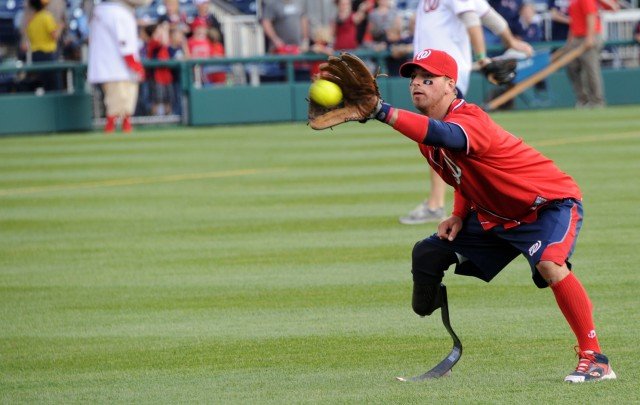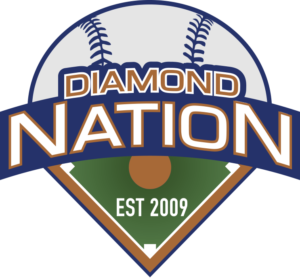“The reason for being on that field is to re-experience what it means to be a ballplayer long after each had an experience that left him wondering if he would even live, let alone regain former athletic abilities.”
Steven Clarfield, a clinical psychologist and a softball buff from New Jersey, was in Panama City Beach, Florida taking in the USSSA Military World Softball Tournament when he saw something he never considered a possibility.
“Nothing in my 55 years on or near a softball field prepared me for what I experienced (that day) in August of 2013,” Dr. Clarfield says, in the introduction to his wonderful book, “Battlefield to Ball Field.”
Clarfield watched as a full team of amputees competed in a high-level softball game against a team of able-bodied men. This was no exhibition. These teams were competing like every other team in the tournament. Winning was not a wish or a hope. It was their intent.
“The only way you can insult this team is to not give them your best,” said Clarfield. “Don’t let up until the game is over, because Wounded Warrior Amputee Softball players approach every game like it might be their last and they wish to squeeze every ounce of competitive joy from the experience.”
That joy for the game is what drew Clarfield to the tournament and a curiosity for what he had heard about the Wounded Warriors Amputee Softball Team brought him to this field in particular.
“The first thing I had to take into account was my own prejudices of what I thought I was going to see,” said Clarfield. “These guys were the poster boys for anti-entitlement. They were expanding the definition of what is possible.” And Clarfield was quickly expanding his expectations.
What Clarfield saw that day – besides the diving stabs, double play attempts and a softball crushed 350 feet by a man with two prosthetic legs – was the fruition of a dream embraced by the gifted and gregarious David Van Sleet.
When Clarfield watched the talented team of Wounded Warriors play so beautifully at a game he held so dear, he knew he had discovered a story that must be told. The trick would be to convince this group of proud and humble military men of his good intentions.
“Talking about softball made it easier,” said Clarfield. “We had that in common. I knew people (in the sport) they knew.” Clarfield had begun pitching in men’s fast pitch softball leagues at the age of 15. Two years later he was playing in interstate tournaments and the sport had permanently entered his bloodstream.
Clarfield had already written two books on softball, “Women’s Fast Pitch Softball: Best of the Best” (2012) and “Ty Stofflet, Softball’s Lefty Legend” (2004).
Clarfield sat down with David Van Sleet the next day, a rainy, down day for the tournament, to discuss what projected as his third and most important book.

“When David read Best of the Best, he found that his experience with the legends of the game mirrored what appeared in the book and he wanted the same kind of approach with (what would become) Battlefield to Ball Field.”
Though he will never assume credit, it was the meticulously organized and personable Van Sleet who was the catalyst for the Wound Warrior Amputee Softball Team. To paraphrase Clarfield, the WWAST story begins with Van Sleet; a man who saw hundreds of returning injured servicemen and pulled together the resources and the wherewithal to make a difference in everyone’s lives.
Van Sleet, also the team’s manager, brought in 20 military veterans from around the country in 2010 and the softball team was born. The team gathers on weekends twice a month to play able-bodied softball teams made up of firefighters, military academy cadets, police officers and the FBI.
Every game the Wounded Warriors play is against able-bodied players and the very first game it played, it provided quite an example of the talent – missing limbs be damned – it had assembled. The Wounded Warriors won 35-10. “They were professionals. Professional soldiers. Professional in every way,” said Bob Duff, chairman and CEO of FedComp, Inc., who helped to set up the game. “They were each missing a body part, but it was more of an inconvenience than a handicap.”
With Van Sleet ably steering the wagon, the WWAST soon went national with a feature on HBO Real Sports and a story in Sports Illustrated by Phil Taylor. Critical sponsorship relationships were built with Louisville Slugger and the Washington Nationals.
“The most powerful thing to me about this story was it was vitally important these players did not leave their athletic lives behind as a result of their injuries and their amputations,” said Clarfield. “And for all of them – any athlete can understand this – they just wanted to play and they wanted to be part of a team.”
Olympic softball legend Jennie Finch had the unique opportunity to not only see the WWAST play but play against them in Louisiana in 2012.
“I was in awe when I met these true heroes and watched them play the game I love,” said Finch, who wrote the book’s preface. “It was amazing to hear their stories and hear first-hand how our game of softball had saved them and given them life after being injured.”
The throngs of fans who come out to see the Wounded Warriors run on one or two prosthetic legs or pivot on double plays or take hacks with just one arm need to hear the individual stories of near death, physical and psychological trauma, and the long, grueling process of recovery, to truly appreciate how far these men have come.

Josh Wege lost both of his legs below the knee and fractured a vertebra in his lower back when his patrol vehicle rolled over a 200-pound improvised explosive device (IED) in Afghanistan. He recalled the emotion of seeing his mother, father, twin brother, three sisters and brother-in-law for the first time at Bethesda Naval Hospital.
“It was one of the best and one of the most painful memories I’ll ever have,” he said, “because I got reunited and my fight to live was almost over. When I was hurt, all I wanted was to see my family one more time.”
Clarfield says the arduous process of recovering from such a traumatic injury is equally mental and physical.
“From a psychological standpoint, this is their identity,” he says. “They’ve become part of a minority. They did not ask for it, but they’ve accepted it. They have a new normal.”
Wege and his WWAST teammates have a common thread that pulled them through the most difficult months of their recovery, according to Clarfield.
“It’s a support system,” he said. “Each had someone who shared the brunt of turning things around. It’s a one-to-two-year process.”
The story of William “Spanky” Gibson is like a live movie reel. During his third tour in Iraq in 2006, he was leading foot patrols when a sniper’s bullet tore apart his left knee. It shredded the tendons, disintegrated the kneecap and severely buckled his leg.
Despite having his left leg amputated from above the knee, he was back on his feet, with the help of a prosthetic, within 18 months. Military regulations prohibit redeployment when a soldier has an amputation above the knee. Nonetheless, Gibson enlisted some connections from within to clear bureaucratic hurdles and became the first above-the-knee amputee in the history of the U.S. military to return to active duty.
Such are the stories of men who have a remarkable will to return to their athletic prowess.
“Each of them was previously a genuine athlete,” said Clarfield. “Suddenly the physical part was taken away from them. This would be only a temporary problem.”
Nate Lindsey was driving a supply truck when his convoy was hit by an IED. He suffered a severe injury to his right arm, which would be amputated below the elbow.
Nate’s problem was more than he was now without the services of half of one limb. Before the injury, he was right-handed. He had to learn how to throw left-handed if he had any desire to play ball again. Playing competitively, though, had not yet entered his mind. It was a simpler wish that pervaded his thoughts.
“Nate was fueled by constant thoughts of his young daughter Jackie,” said Clarfield. “Nate always believed that a father needs to be able to play catch with his children. He wasn’t sure if that was an option anymore. He was going to rehab as hard as he could to find out.”
Lindsey’s inspiration quickly became 10-year major leaguer Jim Abbott, who, despite being born without a right hand and part of his forearm, pitched a no-hitter for the New York Yankees on Sept. 4, 1993. Lindsey not only taught himself to throw left-handed, he became a marvel to watch in the outfield.
It would be wrong, however to hammer home the point that these athletes are driven solely by the wish to return to a competitive field of play. They are also driven by – and this was always part of Van Sleet’s dream – the desire to help their fallen comrades.
“These men are now part of an organization bigger than themselves,” says Clarfield. “They are identified as a service group. They identify with comrades who have died on the battlefield. They remind others that there were others who have it much worse.”
While the WWAST is lifting up their fellow injured warriors throughout the country – be it by their performance on the field or though their hospital visits – they are also doing their part in the development and improvement of prosthetic limbs.
“The athletes believe they have to move 360 degrees. The ball tells them that,” says Clarfield. “Ossur America (a global leader in orthopedics) works with the team to make their prosthetics work best. Ossur believes in the research and development aspect of improving the devices.”
Yes, the Wounded Warrior Amputee Softball Team, in its desire to get the most out of their prosthetic limbs, essentially are field testing top of the line equipment, consequently providing critical feedback to Ossur’s research and development team.
“The Wounded Warrior Amputee Softball Team’s motto is ‘Life Without a Limb is Limitless,’” said David McGill, an Ossur America vice president. “At Ossur, ours is ‘Life without Limitations.”
By example, the Wounded Warrior Amputee Softball Team seems to have the ability to eliminate limitations.
The make a donation to the Wounded Warrior Amputee Softball Team, visit the website https://usawwast.org/tour/.
If you wish to host a WWAST event, email: USAPatriots@thewwast.org

